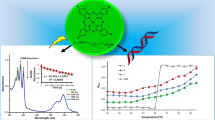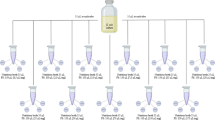Abstract
The photodynamic activity of a cationic Zn(ii) tetramethyltetrapyridinoporphyrazinium salt (ZnPc 2) was compared with that of a non-charged Zn(ii) tetrapyridinoporphyrazine (ZnPc 1), both in vitro using human red blood (HRB) cells and a typical Gram-negative bacterium Escherichia coli. Absorption and fluorescence spectroscopic studies were analyzed in different media. Fluorescence quantum yields (ϕF) of 0.35 for ZnPc 1 and 0.30 for ZnPc 2 were calculated in N,N-dimethylformamide (DMF). The singlet molecular oxygen, O2(1Δg), production was evaluated using 9,10-dimethylanthracene (DMA) in DMF yielding values of ΦΔ = 0.56 for ZnPc 1 and 0.50 for ZnPc 2. In biological medium, the photodynamic effect was first evaluated in HRB cells. Both phthalocyanines produce similar photohemolysis of HRB cells, reaching values >90% of lysis after 5 min of irradiation with visible light. The photodynamic effect is accompanied by an increase in the membrane fluidity of HRB cells. However, these studies on E. coli cells showed that the cationic ZnPc 2 produces a higher photoinactivation of Gram-negative bacteria than ZnPc 1. Also, these results were established by stopped of growth curves for E. coli. Therefore the studies show that cationic ZnPc 2 is an efficient phototherapeutic agent with potential applications in tumor cell and Gram-negative bacteria inactivation by photodynamic therapy.
Similar content being viewed by others
References
R. Bonnett, Chemical aspects of photodynamic therapy, Gordon and Breach Science Publishers, Amsterdam, 2000.
M. C. DeRosa and R. J. Crutchley, Photosensitized singlet oxygen and its applications Coord. Chem. Rev. 2002 233-234 351–371.
P. W. Taylor, P. D. Stapleton and J. P. Luzio, New ways to treat bacterial infections Drug Discovery Today 2002 7 1086–1091.
B. W. Henderson and T. J. Dougherty, How does photodynamic therapy work? Photochem. Photobiol. 1992 55 145–157.
A. Villanueva, R. Vidania, J. C. Stockert, M. Cañete and A. Juarrans, Photodynamic effects on cultured tumor cells. Cytoskeleton alterations and cell death mechanisms, in Handbook of Photochemistry and Photobiology, vol. 4 Photobiology, ed. H. S. Nalwa, American Scientific Publishers, 2002, ch. 3, pp. 79–117.
G. Jori, L. Schindl, A. Schindl and L. Polo, Novel approaches towards a detailed control of the mechanism and efficiency of photosensitized process in vivo J. Photochem. Photobiol. A: Chem. 1996 102 101–107.
M. Ochsner, Photophysical and photobiological processes in photodynamic therapy of tumours J. Photochem. Photobiol. B: Biol. 1997 39 1–18.
R. Ackroyd, C. Kelty, N. Brown and M. Reed, The history of photodetection and photodynamic therapy Photochem. Photobiol. 2001 74 656–669.
N. Kömerik, M. Wilson and S. Poole, The effect of photodynamic action on two virulence factors of Gram-negative bacteria Photochem. Photobiol. 2000 72 676–680.
A. Orenstein, D. Klein, J. Kopolovic, E. Winkler, Z. Malik, N. Keller and Y. Nitzan, The use of porphyrins for eradication of Staphylococcus aureus in burn wound infections FEMS Immunol. Med. Microbiol. 1998 19 307–314.
S. Wood, B. Nattress, J. Kirkham, R. Shore, S. Brookes, J. Griffiths and C. Robinson, An in vitro study of the use of photodynamic therapy for the treatment of natural oral plaque biofilms formed in vivo J. Photochem. Photobiol. B: Biol. 1999 50 1–7.
M. Merchat, G. Bertoloni, P. Giacomini, A. Villanueva and G. Jori, Meso-substituted cationic porphyrins as efficient photosensitizers of Gram-positive and Gram-negative bacteria J. Photochem. Photobiol. B: Biol. 1996 32 153–157.
A. Minnock, D. I. Vernon, J. Schofield, J. Griffiths, J. H. Parish and S. B. Brown, Photoinactivation of bacteria. Use of a cationic water-soluble zinc phthalocyanines to photoinactivate both Gram-negative and Gram-positive bacteria J. Photochem. Photobiol. B: Biol. 1996 32 159–164.
M. Merchat, G. Spikes, G. Bertoloni and J. Jori, Studies on the mechanism of bacteria photosensitization by meso-substituted cationic porphyrins J. Photochem. Photobiol. B: Biol. 1996 35 149–157.
H. Li, O. S. Fedorova, A. N. Grachev, W. R. Trumble, G. A. Bohach and L. Czuchajowski, A series of meso-tris(N-methyl-pyridiniumyl)-(4-alkylamidophenyl)poephyrins: synthesis, interaction with DNA and antibacterial activity Biochim. Biophys. Acta 1997 1354 252–260.
Y. Nitzan, A. Balzam-Sudakevitz and H. Ashkenazi, Eradication of Acinetobacter baumanni by photosensitized agents in vitro J. Photochem. Photobiol. B: Biol. 1998 42 211–218.
L. Polo, A. Segalla, G. Bertoloni, G. Jori, K. Schaffner and E. Ruddi, Polylysine-porphycene conjugates as efficient photosensitizers for the inactivation of microbial pathogens J. Photochem. Photobiol. B: Biol. 2000 59 152–158.
J. A. Lacey and D. Phillips, The photosensitization of Escherichia coli using disulfonated aluminium phthalocyanines J. Photochem. Photobiol. A: Chem. 2001 142 145–150.
E. Reddi, M. Ceccon, G. Valduga, G. Jori, J. C. Bommer, F. Elisei, L. Latterini and U. Mazzucato, Photophysical properties and antibacterial activity of meso-substituted cationic porphyrin Photochem. Photobiol. 2002 75 462–470.
Y. Nitzan and H. Ashkenazi, Photoinactivation of Acinetobacter baumannii and Escherichia coli B by cationic hydrophilic porphyrin at various light wavelengths Curr. Microbiol. 2001 42 408–414.
A. Segalla, C. D. Borsarelli, S. E. Braslavsky, J. D. Spikes, G. Roncucci, D. Dei, G. Chiti, G. Jori and E. Reddi, Photophysical, photochemical and antibacterial photosensitizing properties of a novel octacationic Zn(ii)-phthalocyanine Photochem. Photobiol. Sci. 2002 1 641–648.
J. Zhang, X. Wu, X. Cae, F. Yang, J. Wang, X. Zhou and X. L. Zhang, Synthesis and antibacterial study of 10,15,20-triphenyl-5-{4-hydroxy-3-(trimethylammonium)methyl} phenylporphyrin as models for combination of porphyrin and alkylating agent Bioorg. Med. Chem. Lett. 2003 13 1097–1100.
H. Ashkenazi, Y. Nitzan, D. Gá, Photodynamic effects of antioxidant substituted porphyrin photosensitizers on Gram-positive and Gram-negative bacteria Photochem. Photobiol. 2003 77 186–191.
M. E. Milanesio, M. S. Moran, E. I. Yslas, M. G. Alvarez, V. Rivarola and E. N. Durantini, Synthesis and biological evaluation of methoxyphenyl porphyrin derivatives as potential photodynamic agents Bioorg. Medicinal Chem 2001 9 1943–1949.
M. E. Milanesio, M. G. Alvarez, E. I. Yslas, C. D. Borsarelli, J. J. Silber, V. Rivarola and E. N. Durantini, Photodynamic studies of metallo 5,10,15,20-tetrakis(4-methoxyphenyl) porphyrin: photochemical characterization and biological consequences in a human carcinoma cell line Photochem. Photobiol. 2001 74 14–21.
I. Scalise and E. N. Durantini, Photodynamic effect of metallo 5-(4-carboxyphenyl)-10,15,20-tris(4-methylphenyl) porphyrins in biomimetic media J. Photochem. Photobiol. A: Chem. 2004 162 105–113.
M. G. Alvarez, F. Morán, E. I. Yslas, N. B. Rumie Vittar, M. Bertuzzi, E. N. Durantini and V. Rivarola, Pharmacokinetic and tumour-photosensitizing properties of methoxyphenyl porphyrin derivative Biomed. Pharmacother. 2003 57 163–168.
M. E. Milanesio, M. G. Alvarez, J. J. Silber, V. Rivarola and E. N. Durantini, Photodynamic activity of monocationic and non-charged methoxyphenylporphyrin derivatives in homogeneous and biological media Photochem. Photobiol. Sci. 2003 2 926–933.
C. Marti, S. Nonell, M. Nicolau and T. Torres, Photophysical properties of neutral and cationic tetrapyridinoporphyrazines Photochem. Photobiol. 2000 71 53–59.
A. Juarranz, A. Villanueva, V. Diaz, L. Rodríguez-Borlado, C. Trigueros, M. Cañete, Induced photolysis of rabbit red blood cells by several photosensitizers Anti-Cancer Drugs 1993 4 501–504.
I. Rosenthal, V. Y. Shafirovich, N. E. Geacintov, E. Ben-Hur and B. Horowitz, The photochemical properties of fluoroaluminum phthalocyanine Photochem. Photobiol. 1994 60 215–220.
M. Khalili and L. I. Grossweiner, Sensitization of photohemolysis by benzoporphyrin derivative monoacid ring A and porphyrins J. Photochem. Photobiol. B: Biol. 1997 37 236–244.
M. Hoebeke, H. J. Schuitmaker, L. E. Jannink, T. M. A. R. Dubbelman, A. Jakobs, A. Van de Vorst, Electron spin resonance evidence of the generation of superoxide anion, hydroxyl radical and singlet oxygen during the photohemolysis of human erythrocytes with bacteriochlorin a Photochem. Photobiol. 1997 66 502–508.
A. Marozienė, R. Kliukienė, J. Šarlauskas, N. Čėnas, Inhibition of phthalocyanine-sensitized photohemolysis of human erythrocytes by polyphenolic antioxidants: description of quantitative structure-activity relationships Cancer Lett. 2002 157 39–44.
I. B. Zavodnik, L. B. Zavodnok and M. J. Bryszewska, The mechanism of Zn-phthalocyanine photosensitized lysis of human erythrocytes J. Photochem. Photobiol. B: Biol. 2002 67 1–10.
W. S. Chan, M. Zuk and E. Ben-Hur, Phthalocyanines, in Photodynamic tumor therapy, 2nd and 3rd generation photosensitizers, ed. J. G. Moser, Harwood Academic Publishers, Amsterdam, 1998, ch. 2.4, pp. 63–73.
A. Minnock, D. I. Vernon, J. Schofield, J. Griffiths, J. H. Parish and S. B. Brown, Mechanism of uptake of a cationic water-soluble pyridinium zinc phthalocyanine across the outher membrane of Escherichia coli Antimicrob. Agents Chemother. 2000 44 522–527.
J. N. Demas and G. A. Crosby, The measurement of photoluminescence quantum yields J. Phys. Chem 1971 75 991–1024.
P. G. Seybold and M. Gouterman, Porphyrins XIII: fluorescence spectra and quantum yields J. Mol. Spectrosc. 1969 31 1–13.
G. L. Indig, G. S. Anderson, M. G. Nichols, J. A. Bartlelett, W. S. Mellon and F. Sieber, Effect of molecular structure on the performance of triarylmethane dyes as therapeutic agents for photochemical purging of autologous bone marrow grafts from residual tumor cells J. Pharm. Sci. 2000 89 88–99.
R. W. Redmond and J. N. Gamlin, A compilation of singlet yields from biologically relevant molecules Photochem. Photobiol. 1999 70 391–475.
I. Seotsanyana-Mokhosi, N. Kuznetsova and T. Nyokong, Photochemical of tetra-2,3-pyridinoporphyrazines J. Photochem. Photobiol. A: Chem. 2001 140 215–222.
K. Sakamoto, T. Kato, T. Kawaguchi, E. Ohno-Okumara, T. Urano, T. Yamaoka, S. Suzuki and M. J. Cook, Photosensitizer efficacy of non-peripheral substituted alkylbenzopyridoporphyrazines for photodynamic therapy of cancer J. Photochem. Photobiol. A: Chem. 2002 153 245–253.
D. Wöhrle, N. Iskander, G. Graschew, H. Sinn, E. A. Friedrich, W. Maier-Borst, J. Stern and P. Schlag, Synthesis of positively charged phthalocyanines and their activity in the photodynamic therapy of cancer cells Photochem. Photobiol. 1990 51 351–356.
B. M. Aveline and R. W. Redmond, Can cellular phototoxicity be accurately predicted on the basic of sensitizer photophysics? Photochem. Photobiol. 1999 69 306–316.
H. Nicaido and M. Vaara, Molecular basic of bacterial outer membrane permeability Microbiol. Rev. 1985 49 1–32.
M. Vaara, Agents that increase the permeability of outer membrane Microbiol. Rev. 1992 56 395–411.
Author information
Authors and Affiliations
Corresponding author
Rights and permissions
About this article
Cite this article
Dupouy, E.A., Lazzeri, D. & Durantini, E.N. Photodynamic activity of cationic and non-charged Zn(ii) tetrapyridinoporphyrazine derivatives: biological consequences in human erythrocytes and Escherichia coli. Photochem Photobiol Sci 3, 992–998 (2004). https://doi.org/10.1039/b407848a
Received:
Accepted:
Published:
Issue Date:
DOI: https://doi.org/10.1039/b407848a




